

Union Street is a major street in the London Borough of Southwark. It runs between Blackfriars Road to the west and Borough High Street to the east. [1] [2] Southwark Bridge Road crosses in the middle.


Union Street is a major street in the London Borough of Southwark. It runs between Blackfriars Road to the west and Borough High Street to the east. [1] [2] Southwark Bridge Road crosses in the middle.
The eastern part of the street was laid out under a 1774 Act passed for making a new workhouse and for "making a carriage way from the … High Street, through the Greyhound Inn, into Queen Street, and for improving the passage from thence into Gravel Lane, leading towards the Black Friars Bridge Road, in the parish of Christ Church." [3]
In 1782 the Union Hall was opened as the Surrey Magistrates Court in the borough, the JPs having previously sat at the Town Hall in the High Street. The façade of the Hall was retained on the new structure on the site in 2005.
In 1813, Queen Street and Duke Street were renamed Union Street. In 1908 Charlotte Street, at the western end of Union Street, was also renamed to be part of the street yet it clearly has a dislocated junction with it, exacerbated by it starting under the railway viaduct.
A fire at an oil and paint shop in Union Street in April 1885 resulted in the death of Alice Ayres, whose bravery in saving her three nieces captured the public imagination. [4]
Red Cross Burial Ground was a burial ground at the northeast corner of Union Street and Red Cross Way.
The street was called Union Street because it marks the boundary between the two local parishes in the area.
The Union Theatre is a leading fringe venue on the north side of the street. On the south side is Jerwood Space, an arts venue, located in the former Orange Street School. [5] Other art galleries include the RKB Gallery, dedicated to artworks on paper, [6] [7] and the Union Gallery, a contemporary art gallery under the railway arches on the north side, that moved to Teesdale Road in February 2009. [8]
Public houses on the street include the Charles Dickens and the Lord Nelson, named after two famous Englishmen. Dickens lodged in Lant Street not far away as a child.
Southwark Underground station is at the western end. Southwark Street runs in parallel to the north. The road forms part of the B300, linking with The Cut to the west. To the east is Newcomen Street.

Southwark is a district of Central London situated on the south bank of the River Thames, forming the north-western part of the wider modern London Borough of Southwark. The district, which is the oldest part of South London, developed due to its position at the southern end of the early versions of London Bridge, for centuries the only dry crossing on the river. Around 43 AD, engineers of the Roman Empire found the geographic features of the south bank here suitable for the placement and construction of the first bridge.

Bermondsey is a district in southeast London, part of the London Borough of Southwark, England, 2.5 miles (4.0 km) southeast of Charing Cross. To the west of Bermondsey lies Southwark, to the east Rotherhithe and Deptford, to the south Walworth and Peckham, and to the north is Wapping across the River Thames. It lies within the historic county boundaries of Surrey. During the Industrial Revolution Bermondsey became a centre for manufacturing, particularly in relation to tanning. More recently it has experienced regeneration including warehouse conversions to flats and the provision of new transport links.

The London Borough of Southwark in South London forms part of Inner London and is connected by bridges across the River Thames to the City of London and London Borough of Tower Hamlets. It was created in 1965 when three smaller council areas amalgamated under the London Government Act 1963. All districts of the area are within the London postal district. It is governed by Southwark London Borough Council.
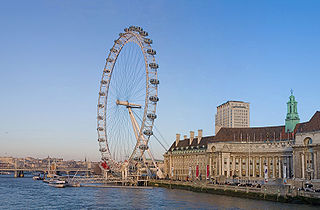
The South Bank is an entertainment and commercial district in central London, England on the south bank of the River Thames opposite the City of Westminster. It forms a narrow strip of riverside land within the London Borough of Lambeth and the London Borough of Southwark,. As such, the South Bank may be regarded as somewhat akin to the riverside part of an area known previously as Lambeth Marsh and North Lambeth.

New Kent Road is a 1 kilometre (0.6 mi) road in the London Borough of Southwark. The road was created in 1751 when the Turnpike Trust upgraded a local footpath. This was done as part of the general road improvements associated with the creation of Westminster Bridge; in effect it was possible to travel from the West End/ Westminster to the south-east without having to go via the Borough of Southwark but could now cross St George's Fields to the junction of Newington Causeway and Newington Butts which is where New Kent Road starts at Elephant & Castle. The route runs eastward for a few hundred yards to the junction of Great Dover Street and Tower Bridge Road, known as Bricklayers Arms, where it joins the original route to the south-east Old Kent Road.

Lambeth is a district in South London, England, in the London Borough of Lambeth. Lambeth was an ancient parish in the county of Surrey. It is situated 1 mile (1.6 km) south of Charing Cross. The population of the London Borough of Lambeth was 303,086 in 2011. The area experienced some slight growth in the medieval period as part of the manor of Lambeth Palace. By the Victorian era the area had seen significant development as London expanded, with dense industrial, commercial and residential buildings located adjacent to one another. The changes brought by World War II altered much of the fabric of Lambeth. Subsequent development in the late 20th and early 21st centuries has seen an increase in the number of high-rise buildings. The area is home to the International Maritime Organization. Lambeth is home to one of the largest Portuguese-speaking communities in the UK, and Portuguese is the second most commonly spoken language in Lambeth after English.

Bankside is an area of London, England, within the London Borough of Southwark. Bankside is located on the southern bank of the River Thames, 1.5 miles (2.4 km) east of Charing Cross, running from a little west of Blackfriars Bridge to just a short distance before London Bridge at St Mary Overie Dock. It is part of a business improvement district known as 'Better Bankside'.

Borough High Street is a road in Southwark, London, running south-west from London Bridge, forming part of the A3 route which runs from London to Portsmouth, on the south coast of England.

St George the Martyr is a church in the historic Borough district of south London. It lies within the modern-day London Borough of Southwark, on Borough High Street at the junction with Long Lane, Marshalsea Road, and Tabard Street. St George the Martyr is named after Saint George. The church is a Grade II* listed building.

Borough Road is in Southwark, London SE1. It runs east–west between St George's Circus and Borough High Street.
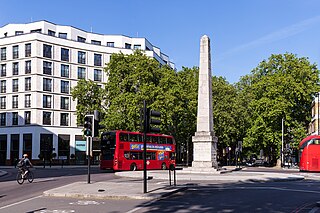
St George's Circus is a road junction in Southwark, London, England. At its centre, which is now a traffic roundabout, is an historic obelisk, designed by Robert Mylne (1733–1811), in his role as surveyor and architect of Blackfriars Bridge.

Southwark Bridge Road is a road in Southwark, London, England, between Newington Causeway near Elephant and Castle and Southwark Bridge across the River Thames, leading to the City of London, in a meandering route.
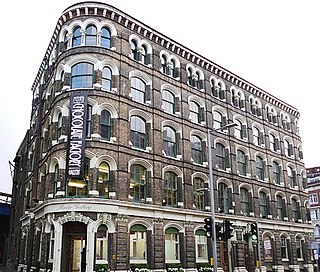
Southwark Street is a major street in Bankside in the London Borough of Southwark, in London England, just south of the River Thames. It runs between Blackfriars Road to the west and Borough High Street to the east. It also connects the access routes for London Bridge, Southwark Bridge and Blackfriars Bridge. At the eastern end to the north is Borough Market.
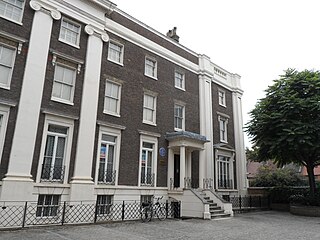
The London Fire Brigade Museum covers the history of firefighting since 1666. The museum houses old fire appliances and other equipment.

Jerwood Space is an arts venue at Bankside on Union Street, Southwark, London. The facilities include rehearsal studios, gallery/exhibition space, meeting rooms, a café, etc. Exhibits include contemporary art and photography throughout the building.
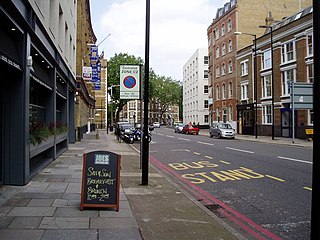
Marshalsea Road is a major street in Southwark, south London, England. At the northwest end is the Southwark Bridge Road. At the southeast end is Borough tube station on Borough High Street. Continuing across the street are Long Lane and Great Dover Street. At the northeast corner is the historic St George the Martyr church, where the Charles Dickens character Little Dorrit was married in Dickens' book of the same name. The area around Marshalsea Road has many Dickens associations.

Cross Bones is a disused post-medieval burial ground on Redcross Way in Southwark, south London. Up to 15,000 people are believed to have been buried there. It was closed in 1853.

Long Lane is a main east–west road in Southwark, south London, England.

Isleworth Cemetery is a cemetery in Isleworth, London Borough of Hounslow, in west London, England.

Tabard Gardens is a small park in Southwark, London. It is located on Tabard Street and gives its name to the surrounding Tabard Gardens Estate. The park was created as part of a slum clearance programme by the London County Council and opened in 1929. It is owned and managed by Southwark Council.
![]() Media related to Union Street, London at Wikimedia Commons 51°30′13″N0°5′53″W / 51.50361°N 0.09806°W
Media related to Union Street, London at Wikimedia Commons 51°30′13″N0°5′53″W / 51.50361°N 0.09806°W